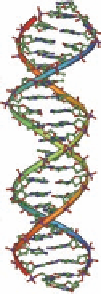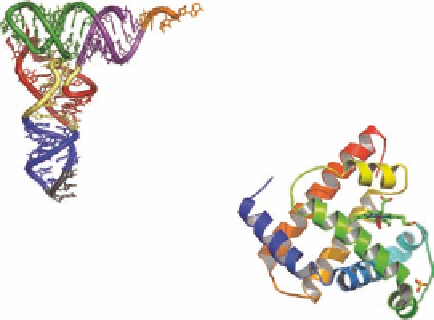Biomedical Engineering Reference
In-Depth Information
RNA
O
Proteins
HO
O
DNA
HO
O
O
O
Me
HO
O
O
Small molecules
FIGURE 4.1
Illustration of the general application of small molecules in studies of biology, illustrated in
relation to the central dogma. (Modii ed from Schreiber, S.L.,
Nat. Chem. Biol
., 1, 64, 2005.)
4.2.1.1 Diversity-Oriented Synthesis
Synthetic chemists have generally strived to prepare predesigned molecules, such as in total chemi-
cal synthesis of complex natural products. Similarly, medicinal chemists are initially designing tar-
get molecules, which subsequently are prepared in the laboratory. Such approaches can be classii ed
as target-oriented synthesis (TAS, Figure 4.2). This mindset was modii ed with the advent of com-
binatorial chemistry, where compounds were designed and prepared in either parallel or combinato-
rial manner, instead of preparing target molecules in a linear fashion. Thus combinatorial chemistry
could provide a signii cantly increased number of compounds and it was believed that this increased
number eventually would lead to an increased number of drugs on the market. However, it appears
as if combinatorial chemistry have not led to the expected revolution in the number of new drug
leads, and it is believed that one of the primary issues is the lack of “diversity,”* that is, that in the
pursuit of generating large number of compounds, the design and diversity of the compounds might
have been compromised.
As a consequence, a fundamental different way of preparing compounds have been proposed,
where rather than producing many compounds with limited diversity, compounds should be instead
generated with a focus on maximizing diversity of the compounds generated (Figure 4.2). These com-
pounds are not directed toward a single biological target, but can be used to identify new ligands for
a number of targets (see Section 4.2.2). The concept of DOS furthermore strives to apply a relatively
limited number of chemical reactions; however, each of these reactions should generate maximal
diversity. When applying DOS, a number of principally different strategies are being used, in particu-
lar strategies that distinguish between building block diversity and skeleton diversity. In the former, a
variation of building blocks are attached to the same scaffold, whereas performing DOS with skeleton
diversity leads to generation of compounds with fundamental changes in the skeleton.
*
It is beyond the scope of this chapter to discuss the philosophical aspects of the term “diversity.” Here it is used to
describe the extent of variation (of predei ned properties) within a set of chemical compounds.





































